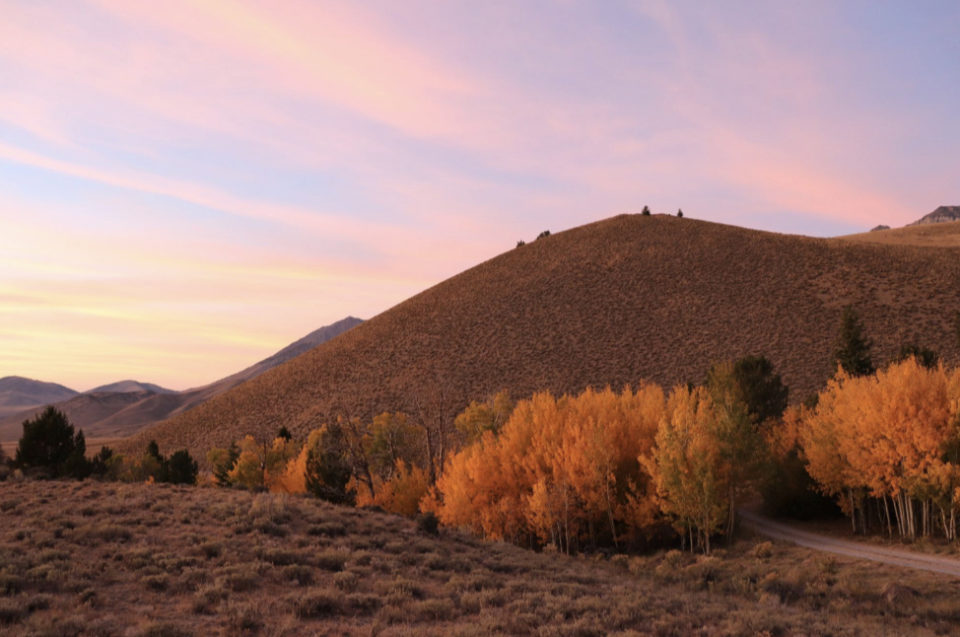Aspen Arnold

The first sign of fall is often associated with dying gardens and colorful forests, but not all trees change colors and wildflowers die. What causes the leaves to change? Which plants will come back next spring? Over time, plants have adapted to their environment, and in the Sawtooths especially, these adaptations are vital for harsh, long winters. Each plant has its own way to beat the snow and bloom again.
The trees that change color are deciduous, this means that every winter they will drop their leaves and grow them back in the spring. Fields of aspen and cottonwoods slow their production of chlorophyll, the green pigment that allows plants to absorb energy from sunlight, and use sweet sap stored in their trunks to feed them through the dark, cold winter. The summer sun triggers new leaf growth and subsequent chlorophyll production. The leaves on deciduous trees are often large and flat in order to absorb as much sun as possible for photosynthesis. In dark forests of pine and fir trees, you will see that the leaves, or needles, have remained attached. These trees have adapted differently to the change in seasons.
Winter gets very cold and dry, you may even use a little more lotion and chapstick in the winter. One of conifers’ biggest challenges in winter is water loss. They have to depend on the water stored in their leaves and trunks. To reduce evaporation, they have long and slim leaves called needles. The needles are also waxy and pointed downward to shed snowpack that could weigh down branches and block sunlight. While they are still able to absorb sunlight and do minimal photosynthesis, most of their nutrients come from sap, like deciduous trees. Trees may have the most visually obvious changes in the seasons, but they are not the only plant life that adapts to winter.

Like trees, shrubs may change color and drop leaves. Shrubs compact themselves low to the ground and have woody stems in order to protect their roots and branches from heavy, cold snow. This also protects their large root system which is filled with vital nutrients and sugars, like the sap in a tree. The leaves of shrubs vary widely and are separated into deciduous and evergreen; evergreen shrubs, like coniferous trees, have needle-like leaves that can shed snow easily. Some evergreen shrubs include juniper and sagebrush (pictured). Some shrubs like willow and wild raspberry have flat, deciduous leaves that absorb sunlight and shed in the fall.

Flowers also have a way to survive harsh winters. There are two types of flowers: annual and perennial. Annuals are flowers like marigolds, fireweed (pictured), and fuchsia. They will bloom most of the season and go to seed when fall begins. They spread their seeds to the soil beneath them and die. Next summer these seeds will grow into new plants that flower throughout the summer. When buying annuals at gardening stores, they are cheaper and more available than perennials.

Perennials will only bloom for a short time during the summer In the winter when they appear dead, they are only dormant, surviving on nutrients stored in the roots. They can return every growing season for 3 to 5 years, finally dying and leaving seeds for the next generation. In the SNRA we have many varieties of perennials including camas, mariposa lily, and aster. In stores, they are much more expensive since they last longer. There are some flowers with a lifespan of only 2 years, these are often called biennials and put in their own category, but often they are just categorized as perennials.
Other understory plants include grasses, sedges, and rushes. “Sedges have edges, rushes are round, grasses have knees that bend to the ground” is a rhyme used to determine the difference between sedges, grass, and rushes.
Grasses can be annual or perennial and are categorized as cool-season plants or warm-season plants. Cool-season plants start slowly growing in early spring, bloom early summer, fruit/seed, and die in late summer. Warm-season grasses grow quickly once the summer heat sets in, fruiting and seeding in the fall, then dying after the first frost. While sedges and rushes may look like grass, they typically grow in or near water, and they are mostly evergreen; they continue to survive through winter due to nutrient reserves. They may even go dormant in hot temperatures!
Like sedges, lichens do not die in the winter, but simply go dormant. Lichen slows growth and allows itself to gain and lose water with humidity levels. Since lichens photosynthesize, they will absorb any sunlight when possible in order to maintain life.

Fungi like mushrooms do not need light to grow, but freezing temperatures can shock the fungi and stunt growth, even killing some species. There are a few types of fungi that grow, even thrive in cold weather, feeding on decomposing wood; those can be difficult to find. Mushrooms easily spread spores through wind, animals, and human intervention. These spores, or mycelium, can survive the winter by staying under the soil waiting for spring. When the temperature rises, the mycelium follows, feeding on decaying material left by winter.
Just like animals growing a thick coat of fur or bears hibernating, plants have found a way to survive all seasons. Winter adaptations vary by plant, but these are a few ways plants are able to cover the earth’s surface, even in the harshest climates.

Aspen worked with SIHA for two seasons as a Naturalist and the Historic Specialist. She loves frolicking through fall forests and foraging for edible and medicinal plants.